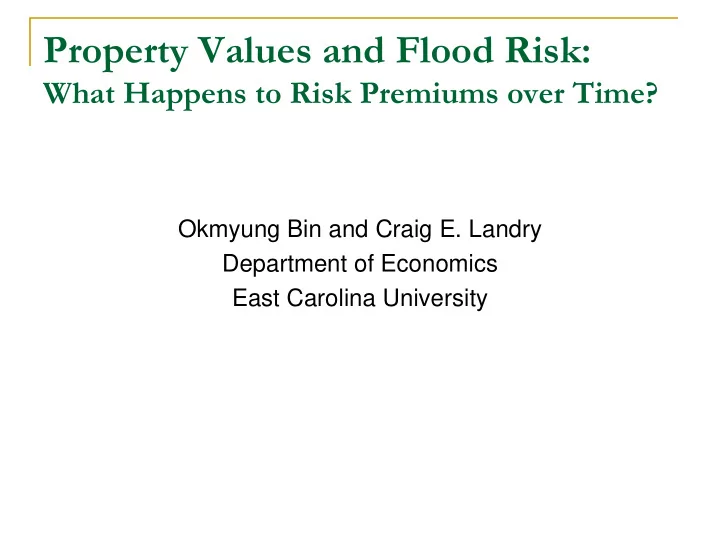

Property Values and Flood Risk: What Happens to Risk Premiums over Time? Okmyung Bin and Craig E. Landry Department of Economics East Carolina University
Property Values and Flood Risk � Previous studies have documented the price reduction from location in a floodplain and compared the price reduction with the capitalized insurance costs. � Shilling, Benjamin, and Sirmans ( The Appraisal Journal 1985) Baton Rouge, LA , 6.4% discount for floodplain location � � MacDonald, Murdoch, and White ( Land Economics 1987) Monroe, LA, 6.3% (above avg. home) and 9.3% (below avg. home) discounts � � Donnelly ( Water Resources Bulletin 1989) La Crosse, WI, 12% discount for floodplain location � � Speyrer and Ragas ( J. of Real Estate Finance and Econ. 1991) New Orleans, LA , 4.2% (suburban) and 6.3% (urban) discounts � � Harrison, Smersh, and Schwartz ( J. of Real Estate Res. 2001) Alachua County, FL, 1.5% (pre-NFIR) and 4.1% (post-NFIR) discounts � � Bin, Kruse, and Landry ( J. of Risk and Insurance 2008) Carteret County, NC, 6.2% (500-year zone) and 7.8% (100-year) discounts �
Property Values and Flood Risk � A common finding is that location within a floodplain lowers property value anywhere from two to twelve percent of average. � With the exception of Harrison, Smersh, and Schwartz (2001), these studies find that the price reduction is more than the capitalized value of insurance premiums. � The study area in Harrison, Smersh, and Schwartz (2001) had not experienced any major flooding in the recent past.
Bin and Polasky (Land Economics 2004) � Hurricane Floyd damaged about 4,300 structures in Pitt County and the total value of property damage was $346 million (Pitt County Finance Office). � Data contain 8,375 single-family residential homes sold between July 1992 and June 2002 in Pitt County, NC. � On average, property values are reduced by an estimated 5.8% when located in a floodplain. � The estimated discount for the floodplain for post-Floyd sales (8.4%) is larger than the discount for pre-Floyd sales (3.8%). � The price differentials for pre-Floyd are smaller than the insurance costs while the differentials for post-Floyd are larger.
Data � Pitt County GIS data as of January 2009 � A total of 3,495 single-family residential properties sold between Sep 1996 and Aug 2002 (6 years) are used for the difference-in-differences analysis. � A total of 3,360 single-family residential properties sold between Sep 2002 and Aug 2008 (6 years) are used for the comparison of risk premiums over time.
A Difference-in Differences Approach � It could be difficult to distinguish the effect of Floyd from the effect of other contemporaneous changes. � It uses a before and after design with a comparison group that did not receive the treatment but was subject to the same contemporaneous influences (Meyer 1995). � The treatment is Hurricane Floyd. � The treatment group is the properties located within a flood zone. � The untreated comparison group is the properties outside the flood zone that do not receive the treatment but experience the contemporaneous influences.
A Spatial Hedonic Model � A spatial autoregressive hedonic model is estimated to account relevant spatial dependence. K ∑ = β + β + γ + γ + γ + ε j j j j ln P X d d d it 0 k kit 1 t 2 3 t it = k 1 ε = λ ε + j j W u it i it ~ γ � The coefficient represents the true causal effect of 3 Hurricane Floyd on the flood-prone property values. ~ γ = − − − 1 1 0 0 ln P lnP ( lnP lnP ) 3 1 0 1 0
MLE Results: 1996-2002 (obs=3,497) Variable Coefficient Std.Error Probability AGE ‐ 0.011 0.001 0.000 SQFT 0.000 0.000 0.000 LOTSIZE 0.009 0.007 0.171 BATHRM 0.278 0.027 0.000 HDWDFLOOR 0.039 0.009 0.000 GASHEAT 0.023 0.008 0.006 FIREPLACE 0.124 0.010 0.000 LNCRK ‐ 0.004 0.003 0.208 LNAIR 0.018 0.015 0.232 LNRAIL 0.008 0.005 0.075 LNTAR ‐ 0.033 0.008 0.000 LNPARK ‐ 0.011 0.006 0.057 FLOOD ‐ 0.042 0.019 0.027 FLOYD 0.019 0.007 0.005 DFLOYD ‐ 0.046 0.026 0.076 LAMBDA 0.465 0.133 0.000
MLE Results: 2002-2008 (obs=3,360) Variable Coefficient Std.Error Probability AGE ‐ 0.010 0.001 0.000 SQFT 0.000 0.000 0.000 LOTSIZE 0.012 0.008 0.156 BATHRM 0.227 0.032 0.000 HDWDFLOOR 0.072 0.011 0.000 GASHEAT ‐ 0.006 0.009 0.493 FIREPLACE 0.112 0.012 0.000 LNCRK 0.000 0.004 0.984 LNAIR 0.015 0.019 0.433 LNRAIL 0.020 0.005 0.000 LNTAR ‐ 0.048 0.008 0.000 LNPARK ‐ 0.017 0.007 0.013 FLOOD ‐ 0.010 0.016 0.536 LAMBDA 0.402 0.057 0.000
Summary � Re-examine the results from Bin and Polasky (2004) using a difference-in-difference framework. � Compare flood zone price differentials for a more recent sample of Pitt County property sales. � Results confirm that the estimated discount for the floodplain for post-Floyd sales (8.8%) is larger than the discount for pre-Floyd sales (4.2%). � Results indicate that the flood risk premiums associated with lower flood risk diminish over time, in the absence of severe storm events.
Recommend
More recommend